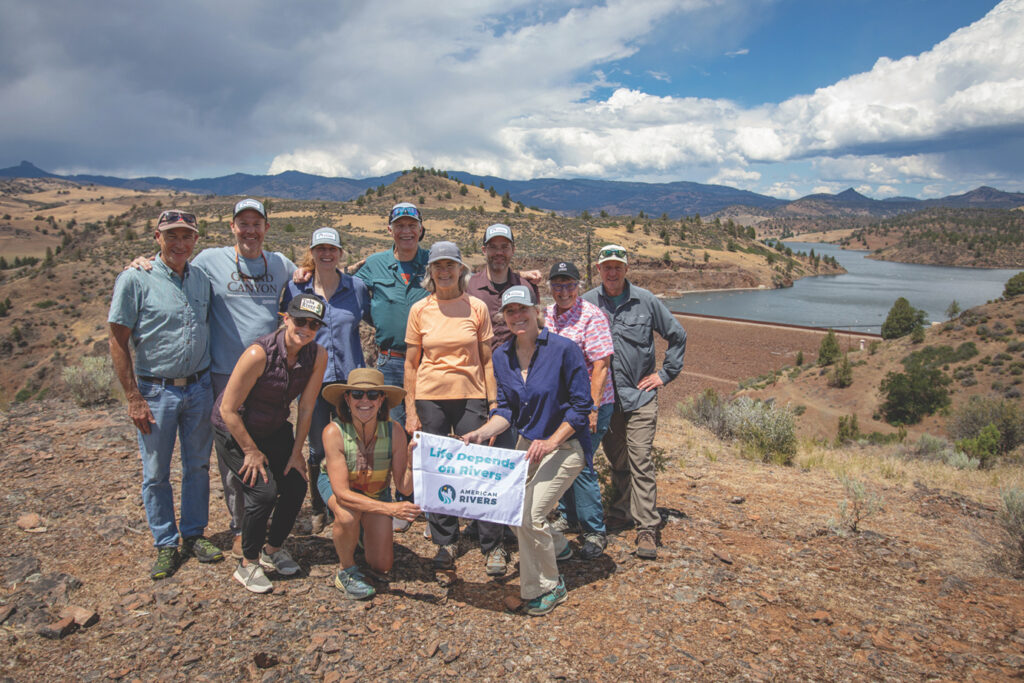The biggest river stories of 2023

American Rivers staff and supporters at the Iron Gate Dam on California’s Klamath River, June 2023 | Photo: Katie Falkenberg
Our successes this year are thanks to you — our supporters, partners, allies, and volunteers. As we reflect on the past 12 months of opportunities and incredible wins, we feel pride in what we achieved for your local rivers. We also feel resolve: We must protect nature in order to save ourselves and the beauty and magic of our planet in the face of climate change, the loss of nature, and racial injustice. With you by our side, we will be fearless in our efforts to protect the rivers close to your heart and others across the country. Because our communities, our health, our wildlife, and our survival itself depend on it.
WIN ✅ We are proud to have played an important role, alongside Tribal Nations and conservation partners, in advocating for the world’s largest dam removal and river restoration project currently underway on Oregon and California’s Klamath River. This time next year, salmon returning from the Pacific Ocean will swim upriver, past where four large dams once blocked their migration. These incredible fish will lay eggs in their spawning grounds and begin their species’ long road to recovery. Even if you’ve never heard of the Klamath, the reality of salmon returning — and what it means to local Tribes and the ecosystem — is breathtaking.
WIN ✅ — Turning Endangered Rivers Into Success Stories
The 10 rivers featured in this year’s America’s Most Endangered Rivers® report underscore how health and safety are threatened by climate change, pollution, dams, and other threats to rivers and communities. Together, we must continue to defend these 10 rivers — and demand greater protections for all 3 million miles of rivers across our country.
Colorado River through the Grand Canyon, Arizona
The Bureau of Reclamation released a simulated flood into the dwindling Colorado River below Glen Canyon Dam. 39,500 cubic feet of water per second were released over 72 hours (that’s billions of gallons) to benefit endangered fish, restore wildlife habitat, rebuild beaches, and protect cultural resources in the canyon. Simulated floods like this one are extremely important to a healthy ecosystem in the Grand Canyon. What does 39,500 CFS look like? Watch the video.
Lehigh River, Pennsylvania
State Rep. Joe Webster introduced a bill to protect riparian buffers — vegetated riverside land that provides habitat, reduces bank erosion, filters pollution, and lowers flood risk. One of our asks in America’s Most Endangered Rivers® of 2023, the bill is especially important because it will help protect the Lehigh and other rivers across Pennsylvania from harmful development and stormwater pollution.
Clark Fork River, Montana
The Clark Fork is threatened by toxic waste left after the Smurfit-Stone pulp mill closed in 2010. By advocating at the local and state levels, we convinced the U.S. Environmental Protection Agency to speed up its testing at the mill site, which we are hopeful will help prompt the Biden administration to order a cleanup of the site.
WIN ✅ — Turning federal $ into action for rivers
American Rivers played a leading role in drafting the legislative language and then securing $1.6 billion for dam removals and dam safety in the Bipartisan Infrastructure Law in 2021. We are now leveraging that funding and coupling it with your support to exponentially increase the number of rivers freed from dams.
- We are overseeing or advising on large, complex dam removal projects around the country. The Albright Power Dam on West Virginia’s Cheat River, for example. The project will open 75 miles of the Cheat and hundreds of miles of tributaries to fi sh species, including walleye, allowing them to secure habitat and food. And for the first time in 70 years, local communities will be able to boat, fi sh, and swim in this section of the Cheat.
- Thanks to our success in bringing together environmental groups, Tribes, and the hydropower industry for the benefit of rivers, American Rivers was selected to lead a $3.7 million project for the U.S. Department of Energy. The goal is to develop recommendations on dam safety, inclusive workforces, the federal dam-licensing process, and greenhouse gas emissions from reservoirs.
STILL FIGHTING ⏳ — Supreme Court Ruling Puts Clean Water at Risk
For 50 years, the Clean Water Act, enacted with bipartisan support, has served as our most fundamental tool for protecting waters across the country. Yet, this past spring, the U.S. Supreme Court released a devastating ruling that dramatically narrowed the act’s scope. The court’s decision in Sackett v. EPA erased critical protections for tens of millions of acres of wetlands and made the clean drinking water sources for millions of Americans vulnerable to pollution and harmful development.
We can’t overstate the implications of the court’s ruling: The rate and severity of flooding and flood damages will worsen, clean drinking water sources for communities will be threatened, wildlife habitat will be destroyed, and water treatment will become more expensive, driving up costs for millions of people. Additionally, when these wetlands are drained and paved over, they will no longer serve as carbon sinks, absorbing carbon dioxide, making our fight against climate change even more of a challenge.
Gutting protection for half of our wetlands is the opposite of how to address the nation’s water and climate crisis. Rivers should unite us, not divide us. American Rivers will continue to stand with local partners and frontline communities to secure equitable protections for rivers and clean water nationwide. We will do everything in our power to work with Congress to rewrite the Clean Water Act and press states to enact tougher laws.
This post originally appeared at americanrivers.org.


